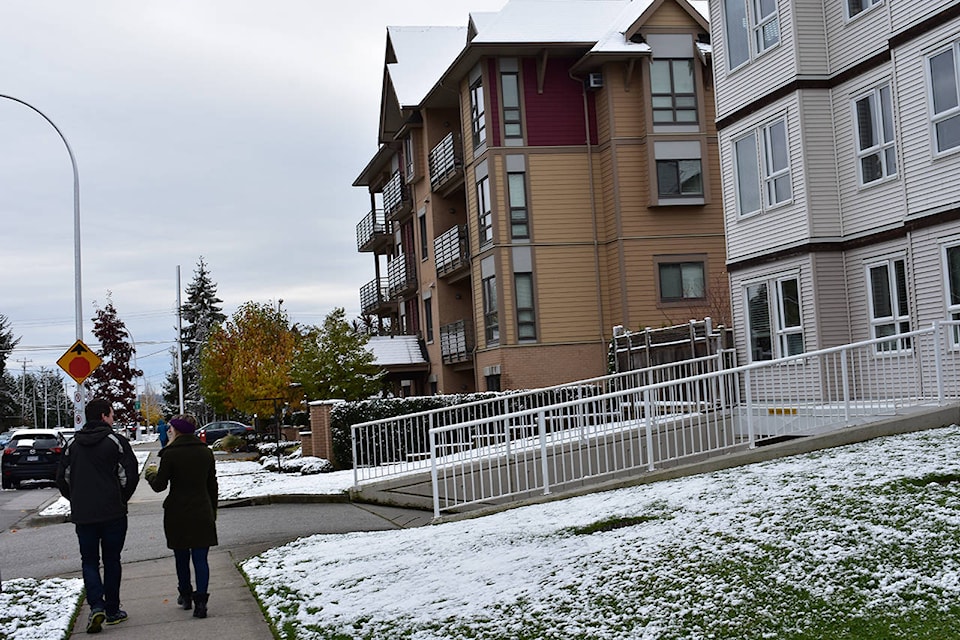Cloverdale is paying more than the rest of Surrey for shelter, but its residents seem more able to pay the bills, according to the 2016 census numbers.
In Surrey, the average shelter cost for homeowners is $1,608 per month; in Cloverdale, it is marginally higher at $1,614 per month. The biggest difference is for renters: in Surrey, renters pay an average of $1,049 a month, while Cloverdalians pay $1,219 per month.
However, fewer renters in Cloverdale are paying 30 per cent or more of their income on housing costs. Canada considers housing affordable if total shelter costs make up less than 30 per cent of a household’s before-tax income.
Overall, around 34 per cent of tenants in Cloverdale spend more than 30 per cent of their income on housing. That percentage is highest in Cloverdale’s town centre, with 40.3 per cent, and in the Port Kells area, with 42.1 per cent. Port Kells also sees the highest average cost for shelter, at $1,430 per month.
In Surrey, 37 per cent of renters have unaffordable housing costs.
If you own your home, the pattern is similar. About 19 per cent of Cloverdale homeowners spend more than 30 per cent of their income on housing, while just under 25 per cent spend that much in Surrey.
In Cloverdale, there are also 11 per cent more homeowners than in Surrey overall, and the homeowners tend to be slightly younger: the majority are between 35 and 44 years old. A slightly smaller, but still significant, percentage of homeowners (23 per cent) are between 45 and 45 years old — the same age as the majority of Surrey homeowners.
The youngest homeowners in Cloverdale are in East Clayton, with around 56 per cent of the homeowners being between 25 and 44 years old. The oldest homeowners tend to be in West Cloverdale and Port Kells, where just over half are between 45 and 64 years old.
This could be, in part, because homes in Cloverdale are valued slightly less than the average in Surrey. Across Cloverdale, the average house has seven rooms and is valued at $741,656. In Surrey, the average house has 6.3 rooms and is valued at $757,863.
However, some areas of Cloverdale are much more expensive than the rest of Surrey. Port Kells, for example, has an average home value of $1,413,543. The least expensive area in Cloverdale is on the Cloverdale-Langley border, between 64 Avenue and 56 Avenue. Homes there are valued at $456,721 on average.
Possibly because families are better able to afford their homes, housing suitability in Cloverdale is higher than in Surrey. Housing suitability is whether the dwelling has enough bedrooms for the size and composition of the household.
According to the National Occupancy Standard, this means there is one bedroom for each cohabitating adult couple, each lone parent, each unattached member of the household over 18, each same-sex pair of children under 18, and each additional boy or girl in the family, unless there are two opposite sex children under 5, in which case they are expected to share a bedroom. A household of one individual can occupy a home with no bedrooms (i.e. a bachelor or studio suite).
In Cloverdale, an average of four per cent of homes are considered unsuitable for the size of household. In the Don Christian and Sunrise areas of Cloverdale, only two per cent of families are living in unsuitable homes, while in Port Kells, that number goes up to seven per cent.
However, even that percentage is significantly lower than the average for Surrey, where nine per cent of homes are considered unsuitable. The average for Metro Vancouver is around seven per cent. ^
A note on the numbers
It is important to note that the numbers are rounded to the nearest five people for privacy reasons in each Cloverdale census tract, the small areas in which Statistics Canada compiles information on residents. This rounding could mean the actual percentages for housing, especially the in regards to the per cent of people paying more than 30 per cent of their income on housing, could be higher or lower than what is stated.
editor@cloverdalereporter.com
Like us on Facebook and follow us on Twitter
